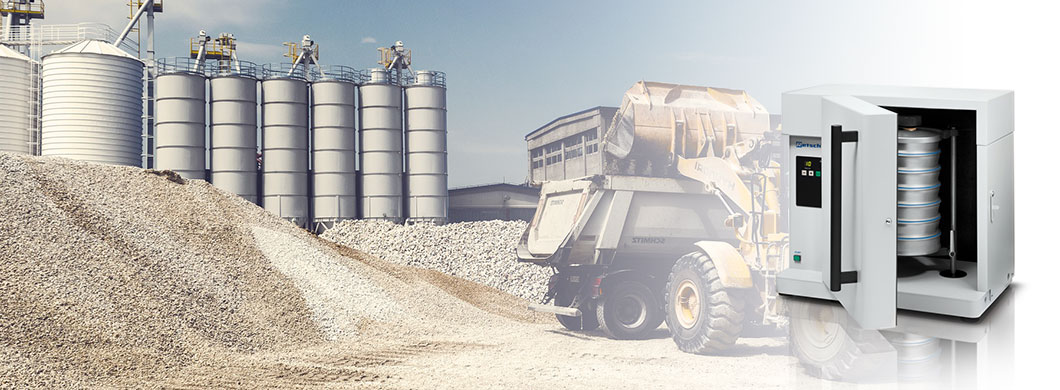What is the Fineness Modulus of Aggregates?
Aug 26, 2019
The fineness or coarseness of an aggregate plays a major part in determining the type of mix design needed to create strong, durable concrete. As such, finding a sample's fineness modulus is required for effective concrete mix proportioning. Discovering an aggregate's fineness modulus is relatively simple if your lab is equipped with the proper tools to perform the analysis.
What is Fineness Modulus?
Fineness modulus (FM) represents the mean particle size of an aggregate sample and is used to help determine proportions for concrete mix design. It also helps to characterize concrete aggregates based on their fineness, making it easier to estimate mix design proportions; if two aggregate samples fall under the same modulus, they will require the same amount of water to produce a mix of the same consistency and concrete of the same strength.
Fineness modulus is typically used for sand or cement mixes, which will typically fall within an FM of 2 - 4, with most coming in between 2.2 - 2.8. As a general rule, the lower the fineness modulus, the finer the particles will be, and the higher the fineness modulus, the coarser they will be.
How is Fineness Modulus Determined?
Sieve analysis is required to determine the fineness modulus of an aggregate specimen. Standard sieve sizes are used in the process, including 4.75mm, 2.36mm, 1.18mm, 0.6mm, 0.3mm and 0.15mm. 9.5mm, 19.0mm and 38.1mm can also be used, increasing at a ratio of 2:1.
Before sieve analysis begins, the dry weight of the sample needs to be noted. Place the aggregate sample in a pan and put it in a dry oven heated to 100 - 110°F. When dry, weigh the sample on a digital scale.
For sieve analysis, arrange the sieve discs from largest to smallest in descending order, with the largest sieve on top. Place them in a mechanical shaker and allow it to disrupt the sample for roughly five minutes. The proportion of aggregates present in each of the sieves can then be used to determine the fineness modulus.
The video above breaks down a relatively simple method of calculating fineness modulus. First, you must weigh the mass retained in each of your sieves and sum those values to find the total mass of the sample; it should be equivalent to the dry weight you determined earlier. Next, calculate cumulative mass retained by finding the sum of the mass retained in your largest sieve (the top sieve) with the mass retained in the second-largest sieve (directly below the top sieve). Then, add the mass retained in the third-largest sieve with the sum of the mass retained in the first two sieves and repeat this until the masses retained in all sieves have been accounted for.
The next step is to find the cumulative percentage of aggregate retained in each sieve, which can be found by dividing the cumulative mass retained in each sieve by the total mass of the sample and multiplying by 100. When all of the cumulative percentages have been calculated, take their sum and divide by 100 to identify the fineness modulus of your aggregate sample.
The following formula can also be used to calculate FM:
F =(F1 x Y + F2 x (1 — Y))
In this equation:
- F is calculated fineness modulus
- F1 is the FM of fine aggregate
- F2 is the FM of coarse aggregate
- Y is the proportion of fine aggregate in a combined aggregate sample
Supplies Needed to Identify Fineness Modulus
A few simple pieces of equipment are needed to perform sieve analysis for the purpose of calculating fineness modulus.
- Sieve Shaker Machines: We carry a variety of sieve shakers for many sieve diameter sizes.
- Aggregate Test Sieves: Find ASTM and ISO compliant sieves in our wide selection.
- Benchtop Ovens: Our ovens pack all the power of an industrial-sized unit in a compact package that can fit comfortably in just about any lab or classroom.
- Material Testing Scales: These scales measure samples less than 1,000 g (2.2 lb.), making them ideal for fineness modulus testing.
Browse All Testing Equipment from Certified MTP
Certified Material Testing Products carries one of the highest quality and most extensive inventories of material testing products online. Whether you're performing sieve analysis for fineness modulus testing or slump testing for concrete consistency, we have the tools and equipment you need for the job. View the rest of our aggregate equipment and more today.

